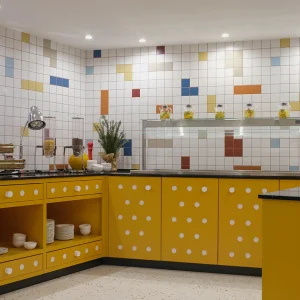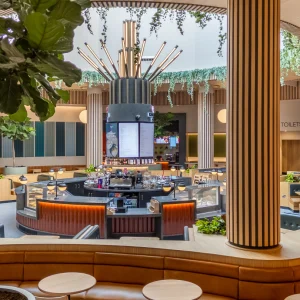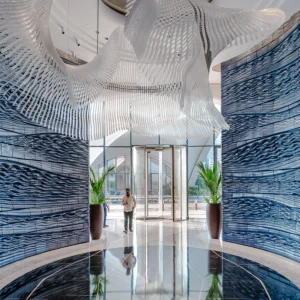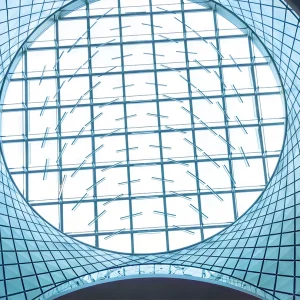
I discovered a great cafe the other day, while browsing along Brick Lane with my tweenage daughter. It was an old warehouse that had been artfully converted with all the right modern, post-industrial boho elements – bare brick walls, rough concrete floor, mismatched wooden furniture, shabby sofas. The coffee machine was churning out a steady stream of lattes and flat whites while the cake and pie display was spectacular enough to render the strictest carb-avoidance diet instantly redundant. The place was full. But something was missing: a buzz. Why? Because everyone was glued to a smartphone or laptop, tapping or scrolling away, mostly silently – though someone was barking at his skype connection to a pal somewhere in the world. Only me and my daughter and a couple in the corner appeared to be actually conversing in an oldschool, analogue format. The place felt dead, as if everyone’s brains were being sucked into their handheld devices. Shame, I thought. Just after the UK fully embraces a continental-style cafe culture, our willingness to accommodate and encourage people’s digital obsessions eliminates the very thing that makes it worth having. Atmosphere.

The digital invasion of public space is something I’ve been monitoring, warily. I’ll admit that I’m not the biggest fan of constant connectivity. I’m all too aware that, in the story of human advancement and technological ‘progress’, where there are pluses there are also usually minuses. For example, the internet has made my remote-working freelance lifestyle possible. But it has also decimated the medium that my freelance skills have historically been targeted at – print journalism. We have to move with the times, yes, but sometimes we have to stop and ask ourselves: is this direction I want to be going in? Now we can work, communicate and orchestrate from anywhere in the world at any time we seem to have lost the freedom NOT to do so, even when we desperately need a great big chunk of downtime.
All of this was brought vividly to mind when I was invited to view a film, Connecting, made by Tom Bassett, the CEO of brand and design strategy firm Bassett & Partners. First screened in the UK at the V&A last September as part of the London Design Festival, this film is a naked piece of evangelism for interactivity.

In it various experts from Nokia, Twitter, Ardhuino and academia expound on how our relationship with consumer electronics is going to become more tactile, more intuitive, more subtle and more invasive. Everything will be networked to everything else. Robert Murdock of Method talks of ‘a mesh-like network that lays over the city and communicates in real time across everything’. Jonas Lowgren, lecturer in interaction design at Malmo University, thinks the next big thing will be our digital worlds colliding with our physical worlds. For example: ‘You could see on the street the footsteps of your friends where they went an hour ago. (Or) you get a blue sense over a block where they’re all hanging out and you know that your friends are there.’
Nice as this may sound, there are so many issues about privacy, and about the opportunities for other, less benign activities to be facilitated by this constant connectivity that I can’t help but see it as ominous when Blaise Aguera Y Arcas, ‘Architect’ of Bing Mobile, says: ‘There’s a superorganism building up in which humans are no longer at the top of the food chain.’ Doesn’t anyone else feel spooked by the prospect of a constantly monitored, constantly interactive digital life, where the ‘network’ is so omnipresent that to unplug is an act of extreme rebellion/connectivity suicide?
We are creatures of the material world. Why else would a ‘connectivity paradigm’ be emerging, as some boffin on Radio 4 described it recently – noting that: ‘The more connected we are digitally, the more we seem to crave real time, physical interfacing with other humans.’ While this may be a boon for the world of conferences, seminars, pop-up screenings and festivals, it may also be a warning sign that we don’t want to go too much further down this route.

In ultra-modern hotels an electronic bellhop guide is the new thing. You can’t even relax in a taxi ride without your calendar being displayed
Stimulating and distracting as it is, it doesn’t satisfy us like the analogue alternative. Like the junk food that famously doesn’t contain enough nutrients to fill us up – so we constantly want to eat more, often leading to heart disease, diabetes and morbid obesity – the answer is NOT to consume more of it. The answer is balance – and consideration. As designers, you have to ask yourselves, while you excitedly brainstorm the latest potential digital innovation to be wrapped around/ inserted into every corner of your bar/ restaurant/building: what is the point of this? Why are we doing it? Who benefits?
But don’t just take my old-school, analogue-loving word for it: Musician Jon Hopkins, the UK’s foremost ‘ambient-techno freedom fighter’ (according to The Guardian newspaper’s recent profile) is no stranger to the screen. Yet he rejects the obsessively interactive habits of the younger generation.
He talks about working with a 20-something composer who ‘had Logic on and he was buying stuff on Amazon at the same time. I thought "How are you getting anything done?" and the answer is: very, very slowly. The human brain is not adapted to living with this amount of stimuli. In order to create, it needs space from all the bullshit and the endless opinions. I just love switching stuff off and going for a run, or sitting down and eating cake.’
It brings to mind the ancient adage you can’t have your cake and eat it. Or perhaps the question should be: given a choice of digital and analogue cake, which would you prefer?





